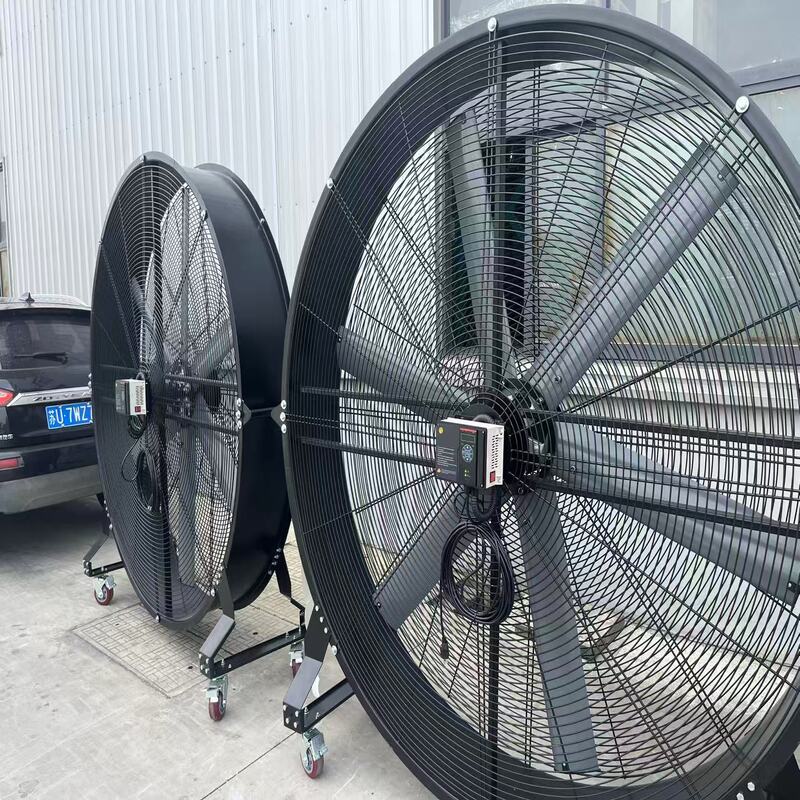What is an HVLS fan?
HVLS (High Volume, Low Speed) fans are large-diameter, low-speed, ceiling-mounted industrial fans. The speed is between 50–200 RPM. The huge fan blades can push a large amount of air even when rotating slowly, driving large-scale ventilation and cooling. They are often used in large spaces such as warehouses, manufacturing workshops and logistics centers.
Main features:
Fan diameter: 7–24 feet (about 2–7 meters), the most common size is 24 feet.
Air volume: up to 400,000 cubic feet per minute (CFM)
Power consumption: 0.5–2.0 kW
Noise: extremely low, usually below 60 decibels (normal human communication sound)
Applicable scenarios: Industrial spaces that require continuous ventilation, large-scale air supply, and low energy consumption.
What is a high-speed fan?
High-speed fans are usually small in size but have high speeds, often exceeding 1,000 RPM. They are mostly wall-mounted or floor-standing and are often used in places where strong fixed-point airflow is required. The most common type in industrial spaces is floor-standing with wheels, as shown below.

Key Features:
Fan Diameter: 20–36 inches (approx. 0.5–0.9 meters)
Air Volume: 5,000–25,000 CFM
Power Consumption: 0.2–1.0 kW
Noise: Much higher than HVLS fans
Applicable scenarios: Used for rapid cooling of local areas and can be flexibly moved, such as workstations, welding areas or near heat sources.
Energy efficiency comparison
HVLS fan: Low energy consumption during continuous operation. One HVLS fan can replace 6-10 high-speed fans. It can significantly reduce the air conditioning load when used with the air conditioning system.
High-speed fan: A single fan consumes less energy, but multiple fans are needed in large spaces. Overlapping wind fields lead to reduced efficiency, and high speed leads to high energy consumption.
Coverage area and airflow performance
HVLS fans can form a vertical air column, which blows down to the ground and then spreads to the surroundings, covering a space of up to 2,000 square meters with even and gentle airflow.
High-speed fans mainly use strong straight-line airflow, which cannot achieve overall airflow circulation and easily cause uneven temperature distribution.
Installation and Maintenance
HVLS fans:
For buildings with a floor height of 12-14 feet or more
Usually require professional installation to ensure structural safety
Use brushless motors, maintenance is worry-free, and usually requires maintenance every few years.
High-speed fan:
Flexible installation, supports DIY installation
Easy to accumulate dust, requires frequent cleaning and maintenance
Easy to move, but short service life
Situations when to choose HVLS fans
HVLS fans are preferred when your factory has the following conditions:
Open space and high ceiling
Requires continuous ventilation in the entire area
Located in hot climate areas or operates year-round
Have energy-saving and consumption-reduction goals
Requires noise
Situations when high-speed fans are suitable
Consider high-speed fans if your factory has the following conditions:
Divided areas, densely populated workstations
Need flexible movement or directional airflow
Temporary or seasonal cooling needs
Budget constraints
Q1: Are HVLS fans better than high-speed fans?
A: Not absolutely. In large space applications, HVLS fans are more energy-efficient and deliver air more evenly; high-speed fans are suitable for local strong air delivery.
Q2: How much area can one HVLS fan cover?
A: Typically, up to 2000 square meters (about 20,000 square feet) can be covered, depending on the ceiling height and fan diameter.
Q3: Do HVLS fans consume a lot of power?
A: Not much. Despite their large size, the energy consumption per square meter is much lower than that of multiple high-speed fans running in parallel.
Q4: Can HVLS fans replace air conditioners?
A: They cannot completely replace air conditioners, but they can significantly reduce air conditioner load, lower energy consumption, and improve overall comfort.
Conclusion
For factory cooling and ventilation, HVLS fans and high-speed fans have their own advantages and disadvantages. HVLS fans are more suitable for enterprises that pursue energy saving, full factory coverage, and long-term stable operation; while high-speed fans are suitable for small-scale, fixed-point cooling or limited budget scenarios.
